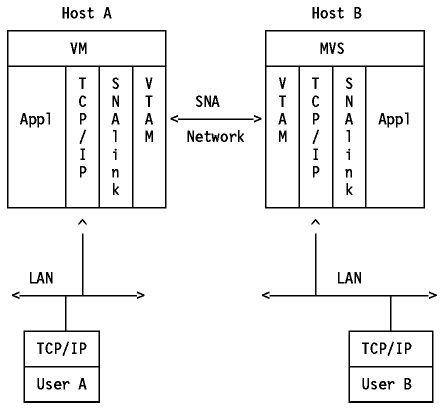 Table of Contents
Table of Contents  Implementations
Implementations Table of Contents
Table of Contents  Implementations
Implementations
Both TCP/IP for VM and TCP/IP for MVS are implemented with the SNAlink function. This function allows the use of an SNA backbone to transfer TCP/IP protocols. A system equipped with TCP/IP and VTAM can be an originator, destination, or router of data originating from such a system.
In order to use this function of TCP/IP, you must have VTAM and TCP/IP installed on each host to be connected via SNAlink. There are two types of SNAlink implementations:
Both SNALINK and SNALNK62 run in a separate address space (in MVS) or virtual machine (in VM) and are used to communicate between TCP/IP and VTAM. (Please see Figure - Principle of SNAlink Function.) Both communicate with TCP/IP using IUCV.
SNALINK communicates via VTAM to its SNALINK partner on the remote host using the LU 0 protocol.
SNALNK62 communicates via VTAM to its SNALNK62 partner on the remote host using the LU 6.2 protocol.
For more details, please refer to the IBM TCP/IP Version 3 Release 1 for MVS: Customization and Administration Guide and IBM TCP/IP Version 2 Release 3 for VM: Planning and Customization.
TCP/IP for OS/2 provides support for an SNAlink LU 6.2 connection in its Extended Networking Kit. For more information refer to TCP/IP V2.0 for OS/2 Extended Networking Guide, SC31-7071.
Note that there is an Internet-Draft describing a method for the transmission of IP over SNA LU6.2. For details, please see [Stevenson, Schwell and Siddall] listed in Bibliography.

From a workstation connected to a LAN using basic TCP/IP functions, User A can access applications on Host A. In addition, User A can TELNET or FTP, via the Host A (transparently using the SNAlink function through a SNA backbone) to Host B.